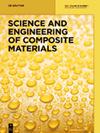苎麻纤维在环氧碳纳米管基体上杂交改善油棕空果束复合材料力学性能
IF 1.6
4区 材料科学
Q3 Materials Science
引用次数: 0
摘要
摘要油棕空果串(OPEFB)以纤维素为纤维,可以转化为具有较高销售价值的复合板。用杂交技术制造复合材料可以改善其性能。本研究将OPEFBs和苎麻纤维结合在环氧-碳纳米管(CNT)基体中。OPEFBs和苎麻纤维的比例不同(3:7、5:5和7:3),总纤维含量为10体积%,基质为90体积%。使用NaOH溶液对纤维进行碱处理以去除表面的杂质。使用硝酸和过氧化氢对CNT进行功能化以提高相容性。对纤维和CNT进行表面处理,以增加复合材料中这些组分之间的结合。与10T复合材料相比,OPEFBs/苎麻纤维的杂化使3:7TR、5:5TR和7:3TR复合材料的抗拉强度分别提高了127%、37%和12%。5:5TR杂化复合材料的抗弯强度比10R复合材料提高了120%,3:7TR和7:3TR复合材料的耐弯强度比10 R复合材料增加了83%。3:7TR杂化复合材料的力学性能最好。本文章由计算机程序翻译,如有差异,请以英文原文为准。
Mechanical property improvement of oil palm empty fruit bunch composites by hybridization using ramie fibers on epoxy–CNT matrices
Abstract Oil palm empty fruit bunches (OPEFBs) can be transformed into composite boards with higher selling value when their cellulose is used as a fiber. Manufacturing composites with hybridization techniques can improve their properties. This study combined OPEFBs and ramie fibers in an epoxy–carbon nanotube (CNT) matrix. The proportion of OPEFBs and ramie fibers was varied (3:7, 5:5, and 7:3), with a total fiber content of 10% by volume and a matrix of 90% by volume. Alkali treatment using NaOH solution was applied to the fiber to remove impurities from the surface. CNTs were functionalized using nitric acid followed by hydrogen peroxide to improve compatibility. Surface treatment was conducted on fibers and CNTs to increase the bonds between these components in the composite material. The hybridization of OPEFBs/ramie fibers improved the tensile strength in the 3:7TR, 5:5TR, and 7:3TR composites by 127, 37, and 12%, respectively, compared to the 10T composite. The flexural strength of the 5:5TR hybrid composite increased by 120%, and that of the 3:7TR and 7:3TR composites increased by 83% against the 10R composite. The 3:7TR hybrid composite showed the best mechanical properties.
求助全文
通过发布文献求助,成功后即可免费获取论文全文。
去求助
来源期刊

Science and Engineering of Composite Materials
工程技术-材料科学:复合
CiteScore
3.10
自引率
5.30%
发文量
0
审稿时长
4 months
期刊介绍:
Science and Engineering of Composite Materials is a quarterly publication which provides a forum for discussion of all aspects related to the structure and performance under simulated and actual service conditions of composites. The publication covers a variety of subjects, such as macro and micro and nano structure of materials, their mechanics and nanomechanics, the interphase, physical and chemical aging, fatigue, environmental interactions, and process modeling. The interdisciplinary character of the subject as well as the possible development and use of composites for novel and specific applications receives special attention.
 求助内容:
求助内容: 应助结果提醒方式:
应助结果提醒方式:


